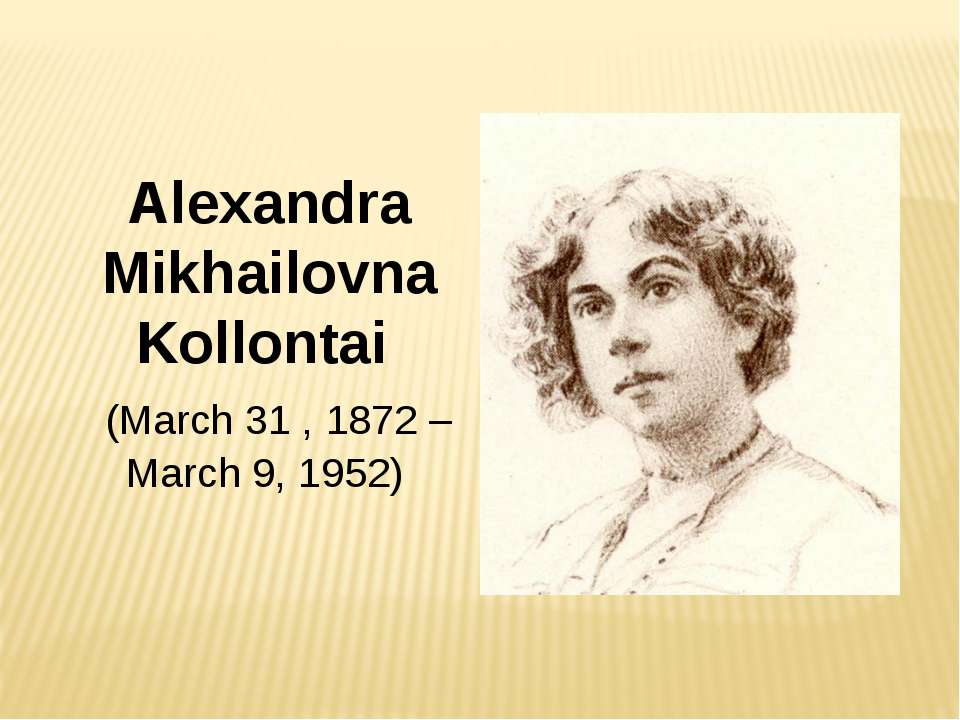Alexandra Mikhailovna Kollontai

- Рубрика: Презентации / Презентации по английскому языку
- Просмотров: 307
Презентация "Alexandra Mikhailovna Kollontai" онлайн бесплатно на сайте электронных школьных учебников edulib.ru
Aleksandra Mikhaylovna Kollontai was a Russian revolutionary, feminist and the first Soviet female diplomat
Alexandra Mikhailovna Domontovich was born on March 31 , 1872 in St. Petersburg Alexandra's mother, Alexandra Androvna Masalina-Mravinskaia Her father, General Мikhail Alekseevich Domontovich
Alexandra Mikhailovna — or "Shura" as she was called growing up — was close to her father with whom she shared an analytical bent and an interest in history and politics. Her relationship with her mother, for whom she was named, was more complex. She later recalled: "My mother and the English nanny who reared me were demanding. There was order in everything: to tidy up toys myself, to lay my underwear on a little chair at night, to wash neatly, to study my lessons on time, to treat the servants with respect. Mama demanded this."
Alexandra was a good student growing up, sharing her father's interest in history, and mastering a range of languages. She spoke French with her mother and sisters, English with her nanny, Finnish with the peasants at a family estate inherited from her mother's father in Kuusa ,and was a student of German. Alexandra thought to continue her schooling at a university, but her mother refused her permission, arguing that women had no real need for higher education, and that impressionable youngsters encountered too many dangerous radical ideas at universities in any event. Instead, Alexandra was to be allowed to take an exam to gain certification as a school teacher before making her way into society to find a husband, as was the custom
In 1890 or 1891, Alexandra, aged around 19, met her future husband Vladimir Ludvigovich Kollontai, and married in 1893. Alexandra became pregnant soon after her marriage and bore a son, Mikhail, in 1894. In her autobiography Alexandra admitted that she "married early, partly as a protest against the will of my parents". Alexandra left her husband after three years of marriage. 1897:With husbund Vladimir and son Misha
She became a member of the Russian Social Democratic Labor Party, aged 27, in 1899. She was a witness of the popular rising in 1905 known as Bloody Sunday, at Saint Petersburg in front of the Winter Palace. 1905: Potrait of Kollontai
In 1904, she joined the Bolshevik faction and conducted classes on Marxism for it. In 1905, she joined with Leon Trotsky in pressing for a more positive attitude toward the newly-emerged Soviets and in pressing for unity of the party factions. She became treasurer of the St. Petersburg Social Democratic Committee.
Between 1900 and 1917 Kollontai participated in the revolutionary underground in Russia, but mostly she lived abroad, where she made her reputation as a theoretician of Marxist feminism. In the prerevolutionary period Kollontai also became known as a skilled journalist and orator. She was aMenshevik, but in 1913, when Bolsheviks Konkordia Samoilova, Inessa Armand, and Nadezhda Krupskaya launched a newspaper aimed at working-class women, they invited Kollontai to be a contributor. She responded enthusiastically.
In 1918 she married Pavel Dybenko, the handsome leader of the Baltic Fleet sailors; they separated in 1922
She visited the United States in 1916 and edited, with Bukharin, the Communist daily Novy Mir [new world] in New York City. In 1917 she returned to Russia to take part in the Bolshevik Revolution. In 1920 she became people's commissar for social welfare. She was a leader of the "Workers' Opposition" that opposed party and government control of trade unions; this position was defeated by Lenin in 1921.
Kollontai joined the people's commissariat for foreign affairs and became (1923) minister to Norway-the first woman to hold that diplomatic rank
After several ministerial appointments she became (1930) minister to Sweden and remained there until 1945.
Alexandra Kollontai died March 9, 1952, less than a month away from her 80th birthday. Grave of Kollontai at the Njvodevichy Cemistry in Moscow.























